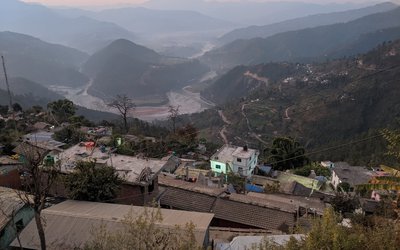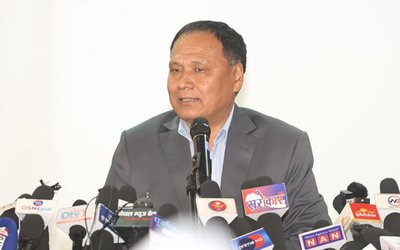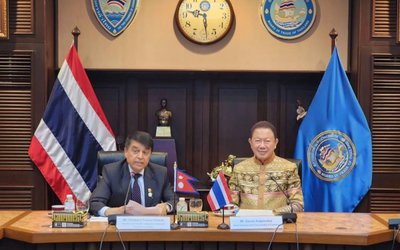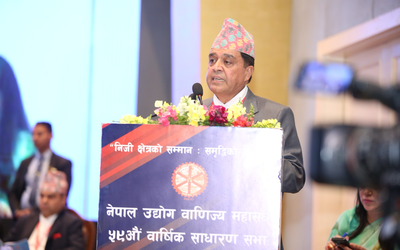
Upper Tamakoshi Hydropower Limited (UTHL) has finally named Mohan Prasad Gautam to the job of Chief Executive Officer (CEO) after more than seven months with an acting CEO. The twelve-member board of directors (two permanent invitees) unanimously decided to name Gautam, an 11th level (Director) of the Nepal Electricity Authority, as the CEO at its 272nd meeting on the 28th of March despite several interventions and the insistence of Kul Man Ghising, Chairman of the Company and Managing Director of the Nepal Electricity Authority (NEA).

Due to the lack of a CEO to make operational choices and resolve issues at the local level, the UTHL generation, which began two years ago, has encountered multiple deadlocks. A week after being hired, Gautam visited the location and got into a fight with the locals, demonstrating his competitive leadership.
The Upper Tamakoshi Hydropower Project, which has a 456 MW installed capacity and was created with domestic investment, was established, and Upper Tamakoshi Hydropower Ltd was established to build, operate, and manage it.
The business intends to construct a separate 21-megawatt project using the head acquired by diverting water from the Rolwaling River and combining it with the reservoir of the Upper Tamakoshi Hydropower Project, therefore Gautam's appointment as CEO is also timely given the current situation.
For the engineering, procurement, and construction phases of the project, contracts have been signed. An additional 105 million units of energy will be produced annually by the project.
Additionally, 216 million extra units of energy are produced when the upper Tamakoshi and Rolwaling rivers are combined. 320 million additional energy units will be added to the grid annually.

CEO Gautam joined the NEA in 2060 and worked at the Upper Tamakoshi Hydroelectric Project in a variety of capacities from 2064 to 2072. From 2072 to 2073, he served as the project manager for the 635 MW Dudhkoshi reservoir project.
From 2073 to 2079, he served as managing director of the Trishuli Hydropower Company, the organization behind the 37 MW Upper Trishuli 3B Hydropower Project.At the moment, he is the authority's representative at Trishuli and Jagdulla Hydropower Company.
Upper Tamakoshi Hydropower Ltd., which has a paid-up capital of 10.59 billion rupees, is owned by the NEA to the tune of 41%. 6% of the company is owned by Nepal Telecommunication Company, while 2% and 2%, respectively, of the founding shares are held by Citizen Investment Fund and National Insurance Institute.
The Employment Provident Fund's depositors own 17.28% of the company, along with 2.88% of the shares held by the company's loan-giving personnel, 8.84% by NEA employees, 15% of the general public, and 10% by Dolakhabasi.
Share Increase
Upper Tamakosi, which only began generation a year ago, has proven that it is a project that will change the game. As a result of the project's massive electricity production, Nepal has gone from being an energy-scarce nation to one with an energy surplus, opening the door for the export of electricity from Nepal to India.
While the global energy crisis forced many nations into a tough financial situation, Upper Tamakoshi has helped Nepal establish a somewhat more comfortable position with extra electricity.
Upper Tamakoshi Hydropower Limited (UTHL) has demonstrated that the project cares about the interests of its shareholders in addition to boosting the national economy by choosing to issue right shares in a 1:1 ratio.
The company's earnings will be increased, and new CEO Gautam has already stated that he will use all of his efforts to enhance dividend payments to the company's public shareholders.

The Upper Tamakoshi Hydropower Project has demonstrated that it may help the nation and its stockholders in the short term and the long term, as it was anticipated would happen a long time ago.
The Upper Tamakoshi Project, which is east of Kathmandu, is being built using funds from within the country. The completion date of the national pride project was originally slated to be in mid-July 2016, but was delayed due to the earthquakes, an Indian trade embargo, and several technical and social challenges.
Since Gautam isn't in charge of the Upper Tamakoshi, the firm intends to issue the appropriate shares. The paid-up capital will increase to 21.18 billion rupees following the issuance of the right share. Upper Tamakoshi's share price is currently less than Rs 500. The NEPSE has listed 105.9 million shares of UPPER.
Organization and funding
Upper Tamakoshi Hydropower Limited, which was founded in March 2007, is an executing agency for carrying out the Project. Four public entities, namely the Nepal Electricity Authority (NEA), Nepal Telecom (NTC), Citizen Investment Trust (CIT), and Rashtriya Beema Sansthan (RBS), own the majority share (51%) of the company. In the company, NEA holds a 41% share, NTC 6%, CIT 2%, and RBS 2% apiece.
Similarly, the general public and residents of Dolakha District will have 15% and 10% share respectively. The remaining 24% share is taken by contributors to Employees Provident Fund (EPF), NEA &Companies staff and staff of financial institutions providing loans.
The delay from Lot 2 Hydro-mechanical Contractor, Upper Tamakoshi Hydropower Project (UTKHEP), which started a commercial generation of electricity last August, has proven to be a game-changer project in Nepal's electricity generation even though it has faced numerous natural and man-made obstructions like earthquakes, COVID-19, and Nepal-India border disruptions.
Nepal's energy status has shifted from being a net importer to becoming an exporter as a result of the project's consistent production. The initiative, which produced less expensive electricity, also assisted in lowering electricity bills and raising NEA's profit. The project has provided several benefits to lenders, consumers, and promoters; nonetheless, the primary issues are how to provide benefits to public shareholders and turn the initiative into a profitable operation.

Upper Tamakoshi Hydropower Limited (UTKHPL) has reported positive financial results for the fourth straight quarterly period. The company has presented bills of Rs. 8 billion, according to the unaudited Statement of Financial Position for the fourth quarter.
On August 20th, UTKHPL began its commercial operation date (COD) with four units, and on September 10th, 2021, all six units will be fully operational.
MD Ghising’s Contribution
The role of Kul Man Ghising's managing director of NEA will always be remembered for the project's successful creation and execution. He made a number of technical judgments that prevented the project from failing. His tireless efforts allowed project work to continue uninterrupted even throughout COVID-19's national lockdown.
The MD and chairman of Company Ghising, who frequently traveled to the project site to oversee the project, played a crucial role in everything from building the tunnel at the earthquake-damaged road to importing a mixture to throw the concrete over penstock and pressuring manufacturer companies to deliver on time.
With its daily peaking reservoir, UTKHPL can generate energy at a full capacity of 456 MW at peak time even during the dry season when the electricity production from the run of the river projects declined drastically.
With a natural head of 822 m and six underground units, it produces up to 2,281 GWh of electricity annually. After Rolwaling HEP commissioning approximately 315 GWh will add at all to Upper. This renewable energy will improve living conditions and promote economic development in the country.
After the commissioning of Rolwaling HEP, the Company UPPER will be in a position to enhance its income by 2 billion annually. This means, a 2 billion annual income added by investing another 8.5 billion for its construction. Moreover, Rolwaling will rescue the financial health of UPPER Tamakoshi.
According to the study, the project is expected to contribute around 1 percent to the GDP and also help boost industrial production. The completion of the project has shown that Nepal can collect the fragmented capital within the country and invest in projects like Upper Tamaoshi.

Started full commercial production from Bhadra 25, 2078, UTKHPL has been generating the electricity in full capacity. However, compared to first and second quarterly, the income in the third 3rd quarter has reduced due to the low flow of water in the river and the reduction of Rs. 83,79,94,492 by NEA. Similarly, payment for increased interest rates and depreciation costs increased the loss amount of the company said unaudited 3rd quarter Statement of Financial Position released on Baisakh 2079.
To expand income, UTKHPL is considering a second expansion stage, the 20-MW Rolwaling Khola Hydroelectric Project (RKHEP), which would contribute another 105 GWh of energy and enhance 210 GWh dry season energy from UTKHEP. After the completion of the process, the financial position will change in better way.
The company's goal right now is to limit other expenses and lower interest since the project's development has already been finished and it is now in the generation stage. Due to delays throughout the construction phase, the project's cost increased.
The company's goal, according to CEO Gautam, is to give investors high dividends, guarantee a sizable income, and bargain with financial institutions to lower interest rates.
Regardless of share, the Upper Tamakoshi has made a significant contribution to the growth of the local infrastructure. Nepal's commercial activity have intensified thanks to the 220 kV Transmission Line, substations, and highways connecting northern distant districts. activities has accelerated.
Gautam has finished the 37 MW Trishuli 3 B project while serving as the managing director of Trishuli Jal Vidhyut Company Limited. The project has now completed a sizable chunk of work after receiving proper guidance and devoted supervision.
As the contractors' mobilization agent, Gautam is a skilled worker. The Upper Tamakosi project will be profitable thanks to MD Gautam and the full support of NEA's management.
After Mrigendra Bahadur Shrestha, the first CEO of the company, had done all essential groundwork to begin building, Bigyan Shrestha concluded the project. At the moment, Gautam is Nepal's largest hydroelectric company's third CEO, and his job is to present a fresh perspective.

SALIENT FEATURES UPPER TAMAKOSHI
Home Salient Features
Type of Development = Peaking Run-of-River (PRoR)
Location = Lamabagar VDC, Dolakha District, Janakpur Zone, Central Development Region
Headworks Location = Lamabagar, Lamabagar VDC
Powerhouse Location = Gongar Gaon, Lamabagar VDC
Maximum Output = 456 MW
Annual Energy = 2,281 GWh
Gross Head = 822 m
Design Discharge = 66.0 m 3 /sec
Hydrology
Catchment Area = 1,745 km 2
Min. Mean Monthly Flow = 14.1 m 3/sec.
Mean Annual Flow = 67.2 m3/sec.
Design flood Q1,000 = 885.0 m3/sec
Diversion Dam = 22 m x 60.0 m (H x L)
Live Storage = 1.2 Million m3
Settling Basins = 2 Nos. L=225 m
Headrace Tunnel = 8.4 km (Cross Sectional Area = 32.14 m2)
Penstock (Vertical Shaft and Horizontal Tunnel) = 1,134.0 m
Power House (Underground) = 142.0m x 13.0m x 25.0 m (L x B x H)
Number of units = 6
Tailrace Tunnel = 2.9 km (Cross Sectional Area = 35.0 m2)
Access Road from Charikot of Dolakha District = 68.0 km
Transmission line = 220 kVA Double Circuit, 47.0 km (Gongar to Khimti Substation)
Upper Tamakoshi Hydropower Limited (UTKHPL)
Annapurna Marga, Gyaneshwor, Kathmandu, Nepal
- NEPAL-THAILAND: Joint Business Council
- Apr 13, 2025
- BIMSTEC SUMMIT: Nepal’s Stand
- Apr 11, 2025
- IME GROUP: Expands Into Paper Industry
- Mar 24, 2025
- CPN UML: Instigated By India
- Mar 23, 2025
- ADB’S CHIEF ECONOMIST: Nepal Reduces Poverty
- Mar 11, 2025















